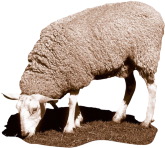Embryo Transfer and Cloning
 Scientists use embryo transfer technology to obtain more offspring from a genetically superior animal. For instance, if a farmer owns a cow that produces excellent milk and wants more cows to produce milk like hers, he can use embryo transfer. How? A scientist collects an embryo (a fertilized ovum) from the cow (called ‘the donor’) and transfers it to another cow (‘the recipient’) to complete the gestation period. With normal reproduction a cow would give birth to 6 or 7 calves during her lifetime; with embryo transfer the same number can be obtained in less than a year.
Scientists use embryo transfer technology to obtain more offspring from a genetically superior animal. For instance, if a farmer owns a cow that produces excellent milk and wants more cows to produce milk like hers, he can use embryo transfer. How? A scientist collects an embryo (a fertilized ovum) from the cow (called ‘the donor’) and transfers it to another cow (‘the recipient’) to complete the gestation period. With normal reproduction a cow would give birth to 6 or 7 calves during her lifetime; with embryo transfer the same number can be obtained in less than a year.
Embryo transfer is required for other reproductive technologies like in vitro fertilization, sperm injection, and cloning by nuclear transfer. In fact, embryo transfer is the predecessor of cloning. But the transition between embryo transfer and cloning was gradual.
In 1952, nuclear transfer experiments with adult frog cells produced viable embryos, but they didn't develop beyond the tadpole stage. In 1986, Steen Willadsen in Cambridge, England, used nucleus transfer to produce sheep. He used embryo cells rather than adult cells. During that time, a company in Texas, Granada Biosciences, employed Willadsen to do nucleus transfer cloning. Granada produced hundreds of calves by nucleus transfer cloning during the '80s and '90s. Finally, in 1997, a group in Scotland used an adult cell from the mammary gland of a sheep, and produced offspring by nuclear transfer; Dolly became the first mammal cloned from an adult cell.
About the Author
Diego Pineda
 Diego holds a master's degree in science and technology journalism from Texas A&M University and work as a science writer for Immunizations for the Public Health (I4PH), a Texas-based nonprofit corporation that provides information services on vaccines and immunizations. He enjoys
writing about genetics, bioethics, and physics -- both in English or
Spanish.
Diego holds a master's degree in science and technology journalism from Texas A&M University and work as a science writer for Immunizations for the Public Health (I4PH), a Texas-based nonprofit corporation that provides information services on vaccines and immunizations. He enjoys
writing about genetics, bioethics, and physics -- both in English or
Spanish.


